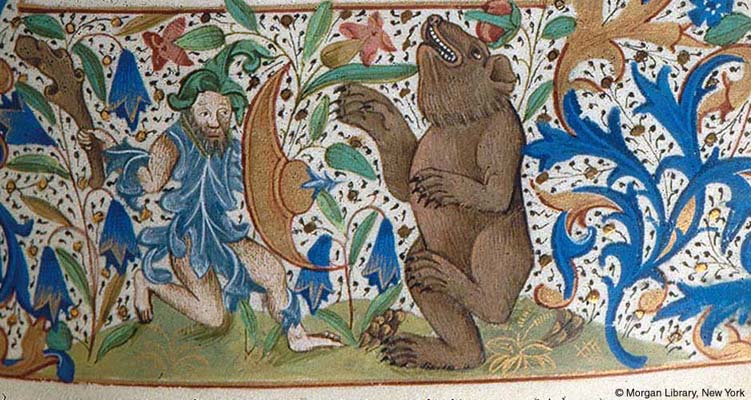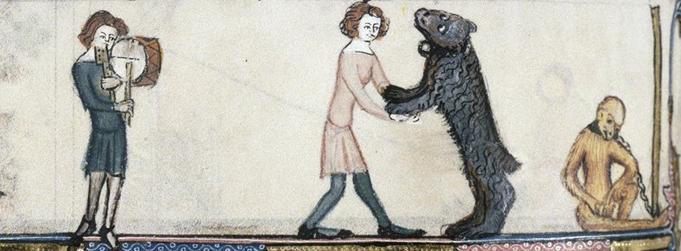Bears have been tamed for entertainment purposes for thousands of years, especially in the Asian world, but European sources don’t mention them until the Middle Ages. Dancing bears were believed to have been a common attraction in these times and more often than not they are depicted in coins, chests, doors, manuscripts and even city seals.
Francisco Alvarez, in his article “Juggling–its history and greatest performers,” makes reference to a rather obscure book titled Collected Stories from London, 1907, from which he provides an interesting passage about the working juggler in the Middle Ages:
The trained bear was led away and the jugglers entered. A man and a boy. They carefully unfolded their bags and began performing. The man, running around in small circles, rapidly juggled with three knives. The boy, whip in hand, would at times, in jest, castigate the man whenever he fumbled. The effect was dexterous, comical, and most entertaining. After the older minstrel had walked on his hands and juggled with balls, the pair collected some coins, folded their bags, and calmly walked away to disappear into the mob. The singers now entered with their music scrolls in hand.
Thiðrekssaga, a Norwegian saga from the 13th century concerned with the adventures of the German hero Dietrich of Bern, contains a peculiar passage about a (fake) dancing bear. The original text of this passage can be read here. For those who do not feel comfortable with reading in Old Norse, here´s a retelling of the passage as it appears in Guerber´s Legends of the Middle Ages:
Wishing to penetrate unrecognized into the enemy’s camp, Wildeber slew and flayed a bear, donned its skin over his armor, and, imitating the uncouth antics of the animal he personated, bade the minstrel Isung lead him thus disguised to Hertnit’s court.
Talking about Bern, you surely noticed that the heraldic beast of the Swiss city of Bern is the bear… even though the bear on the original coat of arms (which dates from 1240) is not dancing. It could well be based on a legend similar to that included in the saga. Konrad Justinger in his chronicle from 1430 sees it rather as a hunted bear:
Nu wart des ersten ein ber gevangen, darumb wart die stat bern genempt; und gab do den burgeren in der stat ein wappen und schilt, nemlich einen swarzen bern in einem wissen schilt in gender wise.
(Then they caught a bear first, which is why the city was called Bern; and so the citizens had their coat and shield, namely, a black bear in a white shield, going upright.)
But the period when dancing bears were most popular was likely the 19th century, when entire families of bear trainers coming from poor mountain zones like Arige and Abruzzo in Italy, Hungary and the Balkans spread throughout Europe with their itinerant shows. If you feel comfortable with French, you can read more about it here.
Surely a dancing bear must have been quite a show at the time. But it must have also been cruel for the poor animal and it wouldn´t be something I would endorse today. Actually, there´s a good number of bear rescue and rehabilitation organizations around luckily because, believe it or not, bears are still made to dance nowadays, especially in Asia. For instance, bear exploitation was abolished in India in 1972 but still hundreds of bears were tortured until 2009 (!), when International Animal Rescue and Wildlife SOS officially put an end to the practice. And there are many other places where they are still being exploited. You can red more about it here at Wildlife SOS.
Now, to a happier subject. If dancing bears were so popular, then surely popular music must have noted their dances. Of course! All across Europe we find different tunes entitled “the bear’s dance” or something similar; funnily enough they all sound different but at the same time they seem to belong to the same “family.”
My friend Jérôme taught me a French version of the tune (with 3 parts) called, of course, “la danse de l’ours.” After some time we started playing it with our band Fiesta Noz! and turned it into a success… everybody who hears it cannot avoid start dancing. Which, as you might agree, can only mean two things: either it is a really good tune or we are all furry Care Bears inside
Check out Fiesta Noz! playing La Danse de l’Ours live:
http://www.youtube.com/watch?v=VjUYTLFhClE
“Dancing Bears: la danse de l’ours” was originally published in Sergio Ribnikov Gunnarson’s blog Sheer Folk, a site well worth visiting. He describes it thusly: “Sheer Folk: the history, the folk, the music, is a blog where music, literature, history, ethnomusicology and life stories intertwine. From Klezmer to Swedish Pastoral music, from the Middle Ages to the 21st century everything woven in an entertaining cultural tapestry. It is also a space where I write about the music I love to listen to and about the music I love to play from my personal perspective.”





